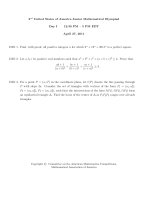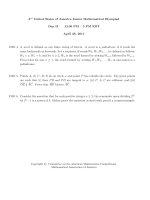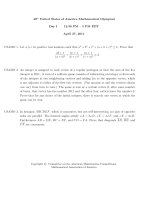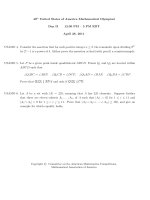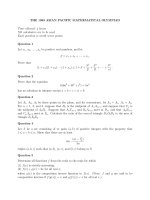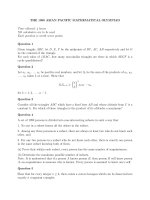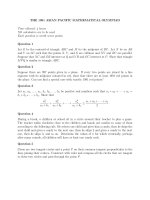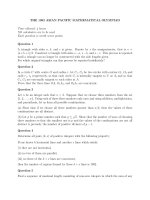ĐỀ THI TOÁN APMO (CHÂU Á THÁI BÌNH DƯƠNG)_ĐỀ 6 doc
Bạn đang xem bản rút gọn của tài liệu. Xem và tải ngay bản đầy đủ của tài liệu tại đây (98.26 KB, 8 trang )
XVII APMO - March, 2005
Problems and Solutions
Problem 1. Prove that for every irrational real number a, there are irrational real numbers
b and b
so that a + b and ab
are both rational while ab and a + b
are both irrational.
(Solution) Let a be an irrational number. If a
2
is irrational, we let b = −a. Then,
a + b = 0 is rational and ab = −a
2
is irrational. If a
2
is rational, we let b = a
2
− a. Then,
a + b = a
2
is rational and ab = a
2
(a − 1). Since
a =
ab
a
2
+ 1
is irrational, so is ab.
Now, we let b
=
1
a
or b
=
2
a
. Then ab
= 1 or 2, which is rational. Note that
a + b
=
a
2
+ 1
a
or a + b
=
a
2
+ 2
a
.
Since,
a
2
+ 2
a
−
a
2
+ 1
a
=
1
a
,
at least one of them is irrational.
1
Problem 2. Let a, b and c be positive real numbers such that abc = 8. Prove that
a
2
(1 + a
3
)(1 + b
3
)
+
b
2
(1 + b
3
)(1 + c
3
)
+
c
2
(1 + c
3
)(1 + a
3
)
≥
4
3
.
(Solution) Observe that
1
√
1 + x
3
≥
2
2 + x
2
. (1)
In fact, this is equivalent to (2 + x
2
)
2
≥ 4(1 + x
3
), or x
2
(x − 2)
2
≥ 0. Notice that equality
holds in (1) if and only if x = 2.
We substitute x by a, b, c in (1), respectively, to find
a
2
(1 + a
3
)(1 + b
3
)
+
b
2
(1 + b
3
)(1 + c
3
)
+
c
2
(1 + c
3
)(1 + a
3
)
≥
4a
2
(2 + a
2
)(2 + b
2
)
+
4b
2
(2 + b
2
)(2 + c
2
)
+
4c
2
(2 + c
2
)(2 + a
2
)
. (2)
We combine the terms on the right hand side of (2) to obtain
Left hand side of (2) ≥
2S(a, b, c)
36 + S(a, b, c)
=
2
1 + 36/S(a, b, c)
, (3)
where S(a, b, c) := 2(a
2
+ b
2
+ c
2
) + (ab)
2
+ (bc)
2
+ (ca)
2
. By AM-GM inequality, we have
a
2
+ b
2
+ c
2
≥ 3
3
(abc)
2
= 12 ,
(ab)
2
+ (bc)
2
+ (ca)
2
≥ 3
3
(abc)
4
= 48 .
Note that the equalities holds if and only if a = b = c = 2. The above inequalities yield
S(a, b, c) = 2(a
2
+ b
2
+ c
2
) + (ab)
2
+ (bc)
2
+ (ca)
2
≥ 72 . (4)
Therefore
2
1 + 36/S(a, b, c)
≥
2
1 + 36/72
=
4
3
, (5)
which is the required inequality.
2
Problem 3. Prove that there exists a triangle which can be cut into 2005 congruent
triangles.
(Solution) Suppose that one side of a triangle has length n. Then it can be cut into n
2
congruent triangles which are similar to the original one and whose corresponding sides to
the side of length n have lengths 1.
Since 2005 = 5 × 401 where 5 and 401 are primes and both primes are of the type
4k + 1, it is representable as a sum of two integer squares. Indeed, it is easy to see that
2005 = 5 × 401 = (2
2
+ 1)(20
2
+ 1)
= 40
2
+ 20
2
+ 2
2
+ 1
= (40 − 1)
2
+ 2 × 40 + 20
2
+ 2
2
= 39
2
+ 22
2
.
Let ABC be a right-angled triangle with the legs AB and B C having lengths 39 and
22, respectively. We draw the altitude BK, which divides ABC into two similar triangles.
Now we divide ABK into 39
2
congruent triangles as described above and BCK into 22
2
congruent triangles. Since ABK is similar to BKC, all 2005 triangles will be congruent.
3
Problem 4. In a small town, there are n ×n houses indexed by (i, j) for 1 ≤ i, j ≤ n with
(1, 1) being the house at the top left corner, where i and j are the row and column indices,
respectively. At time 0, a fire breaks out at the house indexed by (1, c), where c ≤
n
2
.
During each subsequent time interval [t, t + 1], the fire fighters defend a house which is not
yet on fire while the fire spreads to all undefended neighbors of each house which was on
fire at time t. Once a house is defended, it remains so all the time. The process ends when
the fire can no longer spread. At most how many houses can be saved by the fire fighters?
A house indexed by (i, j) is a neighbor of a house indexed by (k, ) if |i − k| + |j −| = 1.
(Solution) At most n
2
+ c
2
−nc −c houses can be saved. This can be achieved under the
following order of defending:
(2, c), (2, c + 1); (3, c − 1), (3, c + 2); (4, c − 2), (4, c + 3); . . .
(c + 1, 1), (c + 1, 2c); (c + 1, 2c + 1), . . . , (c + 1, n).
(6)
Under this strategy, there are
2 columns (column numbers c, c + 1) at which n − 1 houses are saved
2 columns (column numbers c − 1, c + 2) at which n − 2 houses are saved
···
2 columns (column numbers 1, 2c) at which n − c houses are saved
n − 2c columns (column numbers n − 2c + 1, . . . , n) at which n − c houses are saved
Adding all these we obtain :
2[(n − 1) + (n −2) + ··· + (n − c)] + (n − 2c)(n − c) = n
2
+ c
2
− cn − c. (7)
We say that a house indexed by (i, j) is at level t if |i −1|+ |j −c| = t. Let d(t) be the
number of houses at level t defended by time t, and p(t) be the number of houses at levels
greater than t defended by time t. It is clear that
p(t) +
t
i=1
d(i) ≤ t and p(t + 1) + d(t + 1) ≤ p(t) + 1.
Let s(t) be the number of houses at level t which are not burning at time t. We prove that
s(t) ≤ t −p(t) ≤ t
for 1 ≤ t ≤ n − 1 by induction. It is obvious when t = 1. Assume that it is true for
t = k. The union of the neighbors of any k − p(k) + 1 houses at level k + 1 contains at
least k − p(k) + 1 vertices at level k. Since s(k) ≤ k − p(k), one of these houses at level
k is burning. Therefore, at most k −p(k) houses at level k + 1 have no neighbor burning.
Hence we have
s(k + 1) ≤ k − p(k) + d(k + 1)
= (k + 1) − (p(k) + 1 −d(k + 1))
≤ (k + 1) − p(k + 1).
4
We now prove that the strategy given above is optimal. Since
n−1
t=1
s(t) ≤
n
2
,
the maximum number of houses at levels less than or equal to n − 1, that can be saved
under any strategy is at most
n
2
, which is realized by the strategy above. Moreover, at
levels bigger than n − 1, every house is saved under the strategy above.
The following is an example when n = 11 and c = 4. The houses with mark are
burned. The houses with
mark are blocked ones and hence those and the houses below
them are saved.
•
5
Problem 5. In a triangle ABC, points M and N are on sides AB and AC, respectively,
such that MB = BC = CN. Let R and r denote the circumradius and the inradius of the
triangle ABC, respectively. Express the ratio MN/BC in terms of R and r.
(Solution) Let ω, O and I be the circumcircle, the circumcenter and the incenter of ABC,
respectively. Let D be the point of intersection of the line BI and the circle ω such that
D = B. Then D is the midpoint of the arc AC. Hence OD ⊥ CN and OD = R.
We first show that triangles MNC and IOD are similar. Because BC = BM, the line
BI (the bisector of ∠MBC) is perpendicular to the line CM. Because OD ⊥ CN and
ID ⊥ MC, it follows that
∠ODI = ∠NCM (8)
Let ∠ABC = 2β. In the triangle BCM, we have
CM
NC
=
CM
BC
= 2 sin β (9)
Since ∠DIC = ∠DCI, we have ID = CD = AD. Let E be the point of intersection
of the line DO and the circle ω such that E = D . Then DE is a diameter of ω and
∠DEC = ∠DBC = β. Thus we have
DI
OD
=
CD
OD
=
2R sin β
R
= 2 sin β. (10)
Combining equations (8), (9), and (10) shows that triangles MNC and IOD are similar.
It follows that
MN
BC
=
MN
NC
=
IO
OD
=
IO
R
. (11)
The well-known Euler’s formula states that
OI
2
= R
2
− 2Rr. (12)
Therefore,
MN
BC
=
1 −
2r
R
. (13)
(Alternative Solution) Let a (resp., b, c) be the length of BC (resp., AC, AB). Let α
(resp., β, γ) denote the angle ∠BAC (resp., ∠ABC, ∠ACB). By introducing coordinates
B = (0, 0), C = ( a, 0), it is immediate that the coordinates of M and N are
M = (a cos β, a sin β), N = (a − a cos γ, a sin γ), (14)
6
respectively. Therefore,
(MN/BC)
2
= [(a − a cos γ − a cos β)
2
+ (a sin γ − a sin β)
2
]/a
2
= (1 − cos γ − cos β)
2
+ (sin γ −sin β)
2
= 3 − 2 cos γ − 2 cos β + 2(cos γ cos β − sin γ sin β)
= 3 − 2 cos γ − 2 cos β + 2 cos(γ + β)
= 3 − 2 cos γ − 2 cos β − 2 cos α
= 3 − 2(cos γ + cos β + cos α).
(15)
Now we claim
cos γ + cos β + cos α =
r
R
+ 1. (16)
From
a = b cos γ + c cos β
b = c cos α + a cos γ
c = a cos β + b cos α
(17)
we get
a(1 + cos α) + b(1 + cos β) + c(1 + cos γ) = (a + b + c)(cos α + cos β + cos γ). (18)
Thus
cos α + cos β + cos γ
=
1
a + b + c
(a(1 + cos α) + b(1 + cos β) + c(1 + cos γ))
=
1
a + b + c
a
1 +
b
2
+ c
2
− a
2
2bc
+ b
1 +
a
2
+ c
2
− b
2
2ac
+ c
1 +
a
2
+ b
2
− c
2
2ab
=
1
a + b + c
a + b + c +
a
2
(b
2
+ c
2
− a
2
) + b
2
(a
2
+ c
2
− b
2
) + c
2
(a
2
+ b
2
− c
2
)
2abc
= 1 +
2a
2
b
2
+ 2b
2
c
2
+ 2c
2
a
2
− a
4
− b
4
− c
4
2abc(a + b + c)
.
(19)
On the other hand, from R =
a
2 sin α
it follows that
R
2
=
a
2
4(1 − cos
2
α)
=
a
2
4
1 −
b
2
+ c
2
− a
2
2bc
2
=
a
2
b
2
c
2
2a
2
b
2
+ 2b
2
c
2
+ 2c
2
a
2
− a
4
− b
4
− c
4
.
(20)
7
Also from
1
2
(a + b + c)r =
1
2
bc sin α, it follows that
r
2
=
b
2
c
2
(1 − cos
2
α)
(a + b + c)
2
=
b
2
c
2
1 −
b
2
+ c
2
− a
2
2bc
2
(a + b + c)
2
=
2a
2
b
2
+ 2b
2
c
2
+ 2c
2
a
2
− a
4
− b
4
− c
4
4(a + b + c)
2
.
(21)
Combining (19), (20) and (21), we get (16) as desired.
Finally, by (15) and (16) we have
MN
BC
=
1 −
2r
R
. (22)
Another proof of (16) from R.A. Johnson’s “Advanced Euclidean Geometry”
1
:
Construct the perpendicular bisectors OD, OE, OF , where D, E, F are the midpoints
of BC, CA, AB, respectively. By Ptolemy’s Theorem applied to the cyclic quadrilateral
OEAF , we get
a
2
· R =
b
2
· OF +
c
2
· OE.
Similarly
b
2
· R =
c
2
· OD +
a
2
· OF,
c
2
· R =
a
2
· OE +
b
2
· OD.
Adding, we get
sR = OD ·
b + c
2
+ OE ·
c + a
2
+ OF ·
a + b
2
, (23)
where s is the semiperimeter. But also, the area of triangle OBC is OD ·
a
2
, and adding
similar formulas for the areas of triangles OCA and OAB gives
rs = ABC = OD ·
a
2
+ OE ·
b
2
+ OF ·
c
2
(24)
Adding (23) and (24) gives s(R + r) = s(OD + OE + OF ), or
OD + OE + OF = R + r.
Since OD = R cos A etc., (16) follows.
1
This proof was introduced to the coordinating country by Professor Bill Sands of Canada.
8


